Based on our analysis of 30+ case studies and 10 benchmarks, where we tested and compared over 40 products, we identified 120 generative AI use cases across the following categories:
- General genAI applications
- Industry-specific genAI applications
- Business-function-specific genAI applications
For other applications of AI for requests where there is a single correct answer (e.g. prediction or classification), check out AI applications.
You can also see generative AI applications, use cases and real-life examples in a list that you can filter based on various criteria such as business function or industry.
General GenAI Applications
> Video Applications
1. Video Generation
AI-powered video production tools, including AI video generators, content creation platforms, and editing solutions, enable businesses to produce high-quality videos, personalize content, and optimize performance. These tools help reduce costs, manage production, and allow for dynamic, abstract visuals in just minutes.
We assessed leading AI video generation tools to determine their effectiveness in creating high-quality product demonstration videos for eCommerce.
Each AI tool was tested using stock images and scored out of 10 based on Prompt Compliance (accuracy in following instructions), Physical Accuracy (realistic physics and interactions), and Product Integrity (consistency in appearance and details). Here are some of our observations:
- Common issues: Many AI tools struggled with accurately conveying product details, maintaining brand-specific features, and ensuring prompt compatibility.
- Key findings: AI-generated videos are not yet fully reliable for eCommerce product visualization without further refinement. Enhancing prompts and fine-tuning AI models may improve results.
Real-life example: OpenAI’s Sora video generator is being marketed to Hollywood Studios.1
2. Video Prediction
A GAN-based video prediction system:
- Comprehends both temporal and spatial elements of a video
- Generates the next sequence based on that knowledge (See the figure below)
- Distinguishes between probable and non-probable sequences
GAN-based video predictions can help detect anomalies that are needed in a wide range of sectors, such as security and surveillance.
Real-life example: Lucid Dream Network enhanced its video production by utilizing Pictory’s script-to-video tool, which offered pre-built templates and smooth integration of music and visuals.
This innovation helped the company boost its productivity by 350% and amplified its social media reach and engagement by 500%.2
> Image Applications
3. Image Generation
With generative AI, users can transform text into images and generate realistic images based on a setting, subject, style, or location that they specify. Therefore, it is possible to generate the needed visual material quickly and simply.
It is also possible to use these visual materials for commercial purposes that make AI-generated image creation a useful element in media, design, advertisement, marketing, education, etc. For example, an image generator, can help a graphic designer create whatever image they need (See the figure below).

Figure 1: This AI-generated image was produced based on the text description of “Teddy bears shopping for groceries in ukiyo-e style”.3
Real-life example: Coca-Cola, working with OpenAI and Bain & Company, launched the “Create Real Magic” platform.
By utilizing OpenAI’s GPT-4 and DALL-E models for creative generation, this project allowed users to create custom artwork using iconic Coca-Cola imagery, such as the contour bottle and Santa Claus.4
4. Semantic Image-to-Photo Translation
Based on a semantic image or sketch, it is possible to produce a realistic version of an image. Due to its facilitative role in making diagnoses, this application is useful for the healthcare sector.
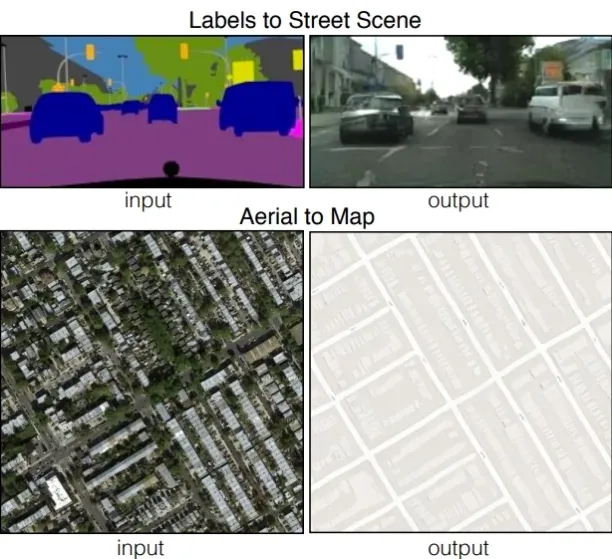
Figure 3: Generating Synthetic Space Allocation Probability Layouts Based on Trained Conditional-GANs.5
5. Image-to-Image Conversion
It involves transforming the external elements of an image, such as its color, medium, or form, while preserving its constitutive elements.
One example of such a conversion would be turning a daylight image into a nighttime image. This type of conversion can also be used for manipulating the fundamental attributes of an image, colorize them, or change their style.
6. Image Resolution Increase (Super-Resolution)
Generative AI uses various methods to create new content based on the existing content. Generative Adversarial Networks (GANs) are one of these methods. A GAN consists of a generator and a discriminator that creates new data and ensures that it is realistic.
GAN-based method allows you to create a high-resolution version of an image through Super-Resolution GANs. This method is useful for producing high-quality versions of archival material and/or medical materials that are uneconomical to save in high-resolution format. Another use case is surveillance purposes.
7. 3D Shape Generation
In this area, research is still in the making to create high-quality 3D versions of objects. Using GAN-based shape generation, better shapes can be achieved in terms of their resemblance to the original source. In addition, detailed shapes can be generated and manipulated to create the desired shape.
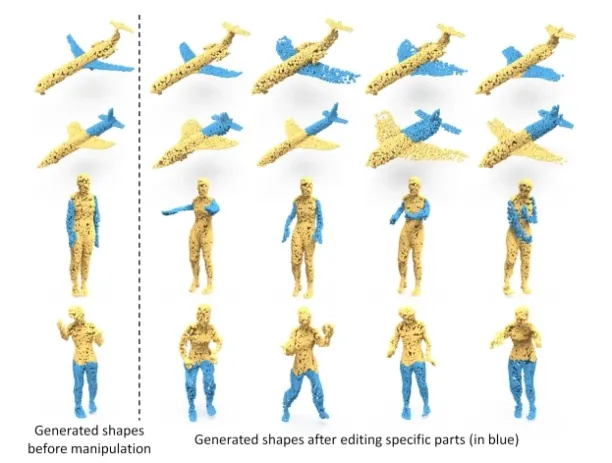
Figure 4: SP-GAN: Sphere-Guided 3D Shape Generation and Manipulation.6
> Audio Applications
8. Text-to-Speech Generator
GANs allow the production of realistic speech audios. To achieve realistic outcomes, the discriminators serve as a trainer who accentuates, tones, and/or modulates the voice.
The TTS generation has multiple business applications such as education, marketing, podcasting, advertisement, etc. For example, an educator can convert their lecture notes into audio materials to make them more attractive, and the same method can also be helpful to create educational materials for visually impaired people. Aside from removing the expense of voice artists and equipment, TTS also provides companies with many options in terms of language and vocal repertoire.
Using this technology, thousands of books have been converted to audiobooks.7
Learn more information on the capabilities of large language models in text generation.
Real-life example: Twilio enhanced its voice synthesis capabilities through collaboration with Amazon Polly, a cloud-based text-to-speech service.
This partnership introduced more than 50 voices across 25 languages to Twilio’s platform and provided developers with new APIs for more advanced speech synthesis control in their voice applications.8
9. Speech-to-Speech Conversion
An audio-related application of generative AI involves voice generation using existing voice sources. With STS conversion, voice overs can be easily and quickly created which is advantageous for industries such as gaming and film.
With these tools, it is possible to generate voice overs for a documentary, a commercial, or a game without hiring a voice artist.
10. Music Generation
Generative AI is also purposeful in music production. Music-generation tools can be used to generate novel musical materials for advertisements or other creative purposes.
In this context, however, there remains an important obstacle to overcome, namely copyright infringement caused by the inclusion of copyrighted artwork in training data.
Learn more about AI ethics.
> Text-based Applications
11. Idea Generation
LLM output may not be suitable to be published due to issues with hallucination, copyrights etc. However, idea generation is possibly the most common use case for text generation. Working with machines in ideation allows users to quickly scan the solution space.
It is surprising to get a machine’s help in becoming more creative as a human. This is possibly because generative AI’s capabilities are quite different (e.g. more flexible, less reliable) than how we typically think about machines’ capabilities.9
12. Text Generation
Researchers appealed to GANs to offer alternatives to the deficiencies of the state-of-the-art ML algorithms. GANs are currently being trained to be useful in text generation as well, despite their initial use for visual purposes.
Creating dialogues, headlines, or ads through generative AI is commonly used in marketing, gaming, and communication industries.
These tools can be used in live chat boxes for real-time conversations with customers or to create product descriptions, articles, and social media content.
A clear example of generative AI in action is using AI email assistants to generate email text. AI email assistants help users save time by generating complete, polished emails from brief prompts, ensuring consistent tone and quality.
They also offer context-aware reply suggestions for incoming emails, allowing quick, efficient responses to routine messages.
Explore more large language model examples and applications like text generation.
For example, a study in 2025 investigated whether people can differentiate between therapy responses written by expert therapists and those generated by ChatGPT, how these responses align with key therapeutic principles, and their linguistic differences.
In a large sample, results showed that participants could rarely distinguish AI-generated responses from those of therapists, and ChatGPT’s responses were rated higher in therapeutic quality. Linguistic analysis suggests that AI’s superior contextualization may contribute to its effectiveness.
While these findings highlight the potential for generative AI to enhance psychotherapy, ethical concerns such as technophobia and the balance between creativity and evidence-based practice must be carefully addressed as AI’s role in mental health continues to evolve.10
Real-life example: Meta AI’s Brain2Qwerty decodes sentences from brain activity during typing, using non-invasive electroencephalography (EEG) and magnetoencephalography (MEG) signals.
Unlike previous methods that required users to imagine movements or focus on external stimuli, Brain2Qwerty interprets natural typing motions, making brainwave decoding more intuitive. The model is composed of three key modules:
- Convolution Module: Extracts spatial and temporal features from EEG and MEG signals.
- Transformer Module: Processes input sequences to enhance understanding and expression.
- Language Model Module: Uses a pre-trained character-level language model to refine and improve text accuracy.
In evaluations, Brain2Qwerty achieved a character error rate (CER) of 67% using EEG and 32% with MEG, with the best-performing participant reaching 19% CER under optimal conditions.
While promising, the approach faces challenges, including the need for real-time decoding, the limited portability and availability of MEG equipment, and further testing for individuals with motor or speech impairments.11
13. Personalized content creation
It can be used to generate personalized content for individuals based on their personal preferences, interests, or memories. This content could be in the form of text, images, music, or other media, and could be used for:
- Social media posts
- Blog articles
- Product recommendations
Personal content creation with generative AI has the potential to provide highly customized and relevant content.
14. Sentiment analysis / text classification
Sentiment analysis, which is also called opinion mining, uses natural language processing and text mining to decipher the emotional context of written materials.
Generative AI can be used in sentiment analysis by generating synthetic text data that is labeled with various sentiments (e.g., positive, negative, neutral). This synthetic data can then be used to train deep learning models to perform sentiment analysis on real-world text data.
It can also be used to generate text that is specifically designed to have a certain sentiment. For example, a generative AI system could be used to generate social media posts that are intentionally positive or negative in order to influence public opinion or shape the sentiment of a particular conversation.
These can be useful for mitigating the data imbalance issue for the sentiment analysis of users’ opinions (as in the figure below) in many contexts such as education, customer services, etc.
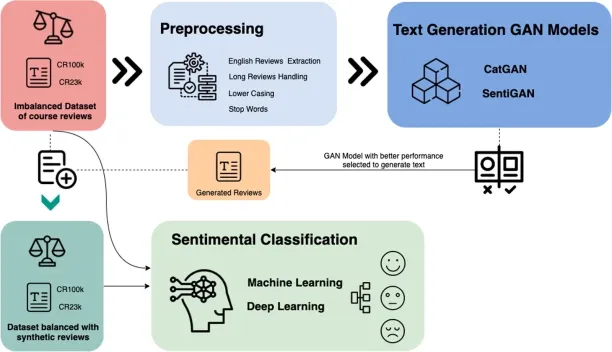
Figure 5: The Impact of Synthetic Text Generation for Sentiment Analysis Using GAN-based Models.12
15. Smart search
Smart Search leverages natural language processing and machine learning to deliver precise and context-aware results. Unlike traditional keyword searches, it understands user intent, processes natural language queries, and provides results based on meaning rather than exact word matches.
Features like autocomplete, real-time suggestions, and faceted filtering allow users to refine searches. Additionally, it can support voice and visual inputs.
Smart search is widely applied across industries. In eCommerce, Smart Search can help customers locate products efficiently, while in enterprise environments, it enables easy retrieval of documents and resources.
Real-life example: Booking.com introduced Smart Filters, a tool that allows users to articulate their preferences in natural language directly within a search box.
For example, a traveler planning a weekend trip to Amsterdam might search for “hotels with a great gym and canal views from the room.” Smart Filters then analyze the input, identify the user’s intent, and apply the most relevant filters from Booking.com’s inventory.13
> Code-based Applications
15. Code generation
Ancileo, a software provider for insurance companies, utilized Amazon Q to improve the efficiency of its developers. Amazon Q helped developers resolve code issues faster, reducing troubleshooting time by 30%.
Additionally, Ancileo integrated ticketing and documentation to enhance onboarding processes and streamline internal communication.
Generative AI enhances software development by automatically generating code, therefore reducing the need for manual programming.
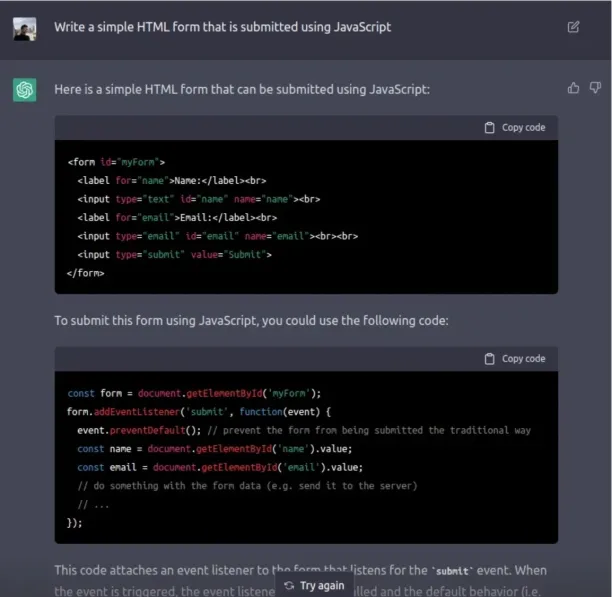
Figure 6: Generating an HTML form and JavaScript submit code with OpenAI’s ChatGPT.
Real-life example: Amazon has introduced Amazon Q, an AI-powered tool that significantly reduces the time and effort required to update foundational software like Java.
This tool automates code transformations, reducing the upgrade time from 50 developer-days to just a few hours, and saving an estimated 4,500 developer-years of work.
In six months, Amazon modernized over half of its Java systems, enhancing security and cutting infrastructure costs, resulting in $260 million in annual efficiency gains. This highlights how AI can drive major productivity improvements in software maintenance for large enterprises.14
16. Code completion
One of the most straightforward uses of generative AI for coding is to suggest code completions as developers type. This can save time and reduce errors, especially for repetitive or tedious tasks.
17. Code review
Generative AI can also be used to make the quality checks of the existing code and optimize it either by suggesting improvements or by generating alternative implementations that are more efficient or easier to read.
18. Bug fixing
It can help identify and fix bugs in the generated code by analyzing code patterns, identifying potential problems, and suggesting fixes.
19. Code refactoring
Generative AI can be used to automate the process of refactoring code, making it easier to maintain and update over time.
20. Code style checking
Generative AI can analyze code for adherence to coding style guidelines, ensuring consistency and readability across a codebase.
Gain more insights into the use of generative AI in automating software development.
21. Generating test cases
Generative tools like ChatGPT can help generate test cases based on user requirements or user stories, provide a clear description of the application’s functionality, and come up with multiple scenarios and test cases to cover various aspects of the application.
22. Generating test code
Tools like ChatGPT can convert natural language descriptions into test automation scripts. Understanding the requirements described in plain language can translate them into specific commands or code snippets in the desired programming language or test automation framework.
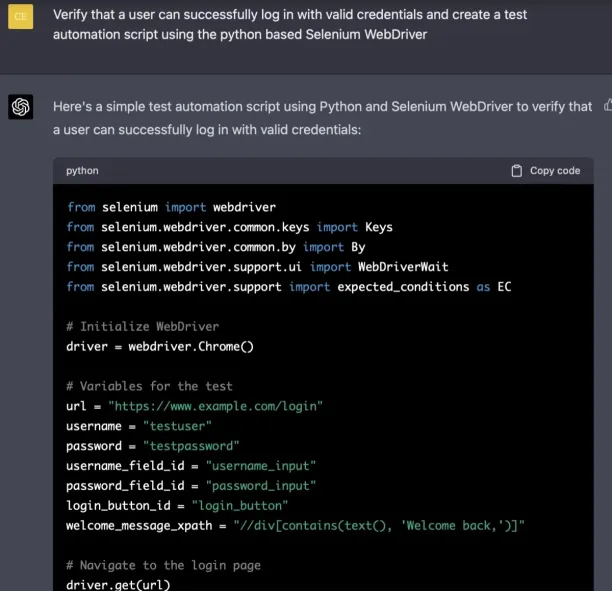
Figure 7: NLP to test scripts via ChatGPT-4.
23. Test script maintenance
As an AI language model, ChatGPT can assist in maintaining test scripts by identifying outdated or redundant code, suggesting improvements, and even automatically updating scripts when provided with new requirements or changes in the application.
24. Test documentation
Generative AI models can generate realistic test data based on the input parameters, such as creating valid email addresses, names, locations, and other test data that conform to specific patterns or requirements.
25. Test result analysis
ChatGPT and other similar tools can analyze test results and provide a summary, including the number of passed/failed tests, test coverage, and potential issues.
Check out test automation use cases with ChatGPT for more.
> Other Applications
26. Conversational AI
Another use case of generative AI involves generating responses to user input in the form of natural language. This type is commonly used in chatbots and virtual assistants, which are designed to provide information, answer questions, or perform tasks for users through conversational interfaces such as chat windows or voice assistants.
ChatGPT is a popular example for conversational AI. It offers a highly informative and integrated conversation to users, like philosophical discussions. For an example, you can check a chat with the ChatGPT below.

Figure 8: A conversation with ChatGPT.
Real-life example: O2, British telecommunications services provider, and VCCP’s AI creative agency Faith launched an innovative campaign to combat phone scammers using Daisy, a lifelike Conversational AI. Daisy is designed to engage scammers in lengthy conversations to protect the public from fraud.
Inspired by a real-life grandmother and modeled after scammers’ stereotypes of elderly victims, Daisy interacts with scammers in real time, sharing fabricated stories, fake bank details, and hobbies like knitting. By deceiving scammers into believing they’ve targeted a real person, Daisy disrupts their operations and highlights common tactics to educate the public on scam prevention.
Daisy’s creation involved advanced AI technology, including a large language model for her personality, a diffusion model for photorealistic visuals, and voice modeling based on a VCCP employee’s grandmother.15
Understand the distinctions between conversational AI and generative AI and navigate through these nuances: Conversational AI vs. generative AI.
27. Data Synthesis
Generative AI can produce synthetic data that mirrors real-world statistics without relying on actual data points, useful for model training, data privacy, and NLP tasks.
28. Data visualization
Some generative models like ChatGPT can perform data visualization which is useful for many areas. It can be used to load datasets, perform transformations, and analyze data using Python libraries like pandas, numpy, and matplotlib.
You can ask ChatGPT Code Interpreter to perform certain analysis tasks and it will write and execute the appropriate Python code. Also, you can ask the model to visualize your data in a preferred format.
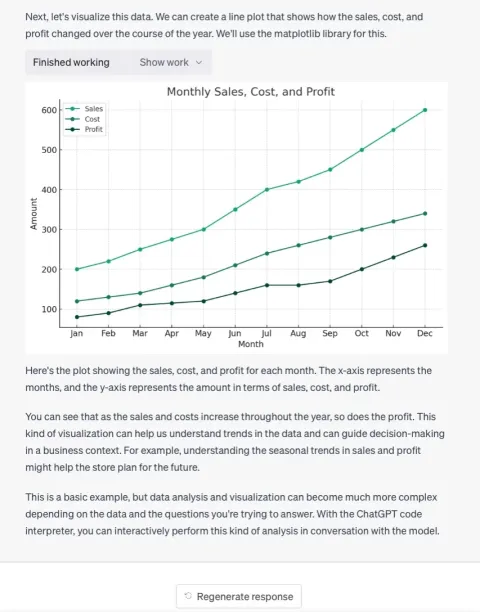
Figure 9: Data analysis with ChatGPT code interpreter.
Learn what is ChatGPT Code Interpreter and its use cases.
29. File conversion
ChatGPT code interpreter can convert files between different formats, provided that the necessary libraries are available and the operation can be performed using Python code.
30. Solving mathematical problems
Generally, large language models are capable of understanding mathematical questions and solving them. This includes basic problems but also complex ones as well, depending on the model. Below is an example of ChatGPT’s capabilities in this.
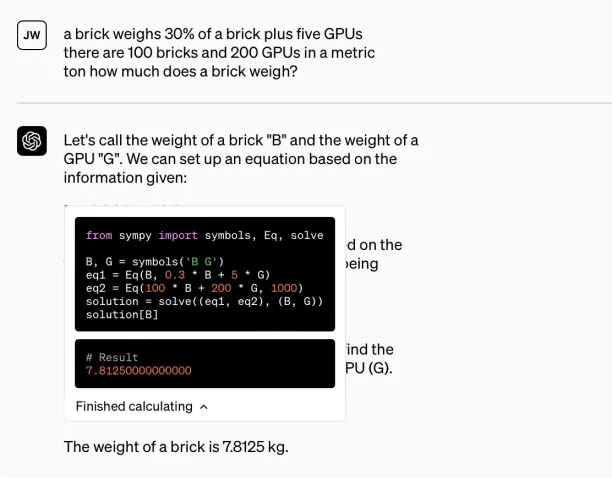
Figure 10: Solving mathematical problems with OpenAI’s ChatGPT plugins.16
Industry specific GenAI Applications
> Healthcare Applications
31. Streamlined drug discovery and development
Leveraging the power of generative AI algorithms to find potential drug candidates and testing their efficacy with computer simulations could vastly expedite the process of discovering new drugs, from preclinical trials on animals to clinical tests on humans.
Real-life example: LeewayHertz17 develops custom AI agents and copilots to streamline drug discovery and helping companies save time and resources across various stages:
- Target identification: Analyzes biological data to identify and prioritize promising drug targets.
- Lead optimization: Screens chemical libraries, generates new molecules, and optimizes molecular properties.
- Preclinical evaluation: Predicts drug behavior and potential interactions, ensuring safety and effectiveness.
- Drug repurposing: Finds new applications for existing drugs by analyzing databases and disease pathways.
- Clinical trial design: Analyzes patient data for targeted trial designs, improving efficiency and success rates.
32. Personalized medicine
Another application of generative AI in personalized medicine is to creating models that can serve as medical chatbots to understand patients symptoms and produce diagnoses with increasing accuracy based on patient declarations and test results.18 Then, these models can craft individualized treatment plans tailored specifically for a patient’s medical history, symptoms and more.
Real-life example: AI4BetterHearts is a global initiative led by the Novartis Foundation, Microsoft AI for Health, and partners to improve cardiovascular health by uniting and analyzing heart health data.
The collaboration aims to break down data silos and leverage machine learning to transform health systems from reactive to preventive care. Partnering with Harvard’s Health Systems Innovation Lab, the initiative examines health system performance across 80 countries, with insights complementing the AI4HealthyCities Health Equity Network.19
33. Improved medical imaging
By combining the power of machine learning with medical imaging technologies, such as CT and MRI scans, generative AI algorithms can accelerate precision in medical imaging with improved results.
34. Population health management
Using generative AI in healthcare can also lead to better population-level health management by allowing policymakers to:
- Access more detailed demographic information
- Design targeted public health initiatives that benefit underserved communities.
Real-life example: BCG and Zeiss developed a generative AI application to help healthcare professionals provide accurate and timely responses to patient inquiries.
This AI tool generates responses based on pre-approved materials and ensures that the accurate information is delivered to patients. Based on early feedback, 79% of AI-generated responses are found to be ready to send without edits.
The application aims to improve patient engagement and allow doctors to focus more on patient care, while potentially boosting demand for treatments.20
35. AI chatbots for symptom checking
Symptom assessment chatbots are designed to help individuals understand and manage their health by asking questions, providing recommendations, and, when necessary, connecting users with healthcare professionals.
These chatbots offer immediate medical guidance and preliminary information for patients to take a proactive approach to their health. By analyzing symptoms, they can also help identify potential health issues early and provide tailored advice.
However, the use of these tools comes with notable limitations:
- Limited diagnostic accuracy: Symptom checkers may lack the expertise of medical professionals, making their diagnostic accuracy unreliable for serious conditions. Users should use them cautiously and not as a replacement for professional advice.
- Lack of empathy: These tools cannot provide the emotional support, reassurance, or personalized guidance that healthcare professionals offer, limiting their ability to meet patients’ emotional needs.
- Over-reliance on chatbots: Dependence on chatbots for medical advice may lead to anxiety from generic or inaccurate information and discourage seeking proper medical care when necessary.
- Legal and privacy concerns: Missteps in advice or handling of personal data could result in legal issues, especially in regions with strict privacy laws like HIPAA. Proper design must prioritize compliance and data security.
36. AI agents in healthcare
AI agents in healthcare can schedule appointments, document patient information, support diagnosis through medical imaging, personalize treatment plans, assist in drug discovery, and automate processes like billing, claims handling, and prior authorizations.
These agents also enhance patient engagement through conversational support, provide real-time health monitoring, offer mental health assistance, detect billing anomalies, and integrate with systems such as Electronic Health Records (EHRs) to support care coordination and improve decision-making.
37. Regulatory documentation automation
Regulatory documentation automation refers to using AI-driven tools to create, review, and manage compliance-related documents in regulated industries such as healthcare and pharmaceuticals.
With this automation, organizations can reduce manual effort, ensure consistency with approved content, and accelerate the drafting of clinical study reports, regulatory submissions, and compliance documents.
Real-life example: Novo Nordisk has adopted Anthropic’s Claude to assist in drafting clinical study reports, reducing the process from weeks to minutes.
By reducing the number of writers from over 50 to just three, the company has achieved a 94% headcount reduction and 92% cost savings, while maintaining accuracy through human oversight.
They leverage retrieval-augmented generation (RAG) to mitigate AI hallucinations, ensuring previously approved content is reused consistently. This approach helped enhance efficiency in regulatory documentation, demonstrating how AI and human collaboration can drive faster and more cost-effective compliance processes.21
> Education Applications
38. Personalized lessons
By leveraging generative AI for education, personalized lesson plans can provide students with the most effective and tailored education possible.
These plans are crafted by analyzing student data such as their past performance, skillset, and any feedback they may have given regarding curriculum content. This helps ensure that each student, especially those with disabilities, is receiving an individualized experience designed to maximize success.
39. Course design
From designing syllabi and assessments to personalizing course material based on students’ individual needs, generative AI can help make teaching more efficient and effective.
When combined with different types of virtual reality, it can also create realistic simulations that will further engage learners in the process.
40. Content creation for courses
Generative AI allows rapid creation of diverse teaching materials, including quizzes and concept reviews. This would help educators quickly generate unique content.
Also, AI can generate scripts for video lectures or podcasts, streamlining multimedia content creation for online courses (see the figure below).
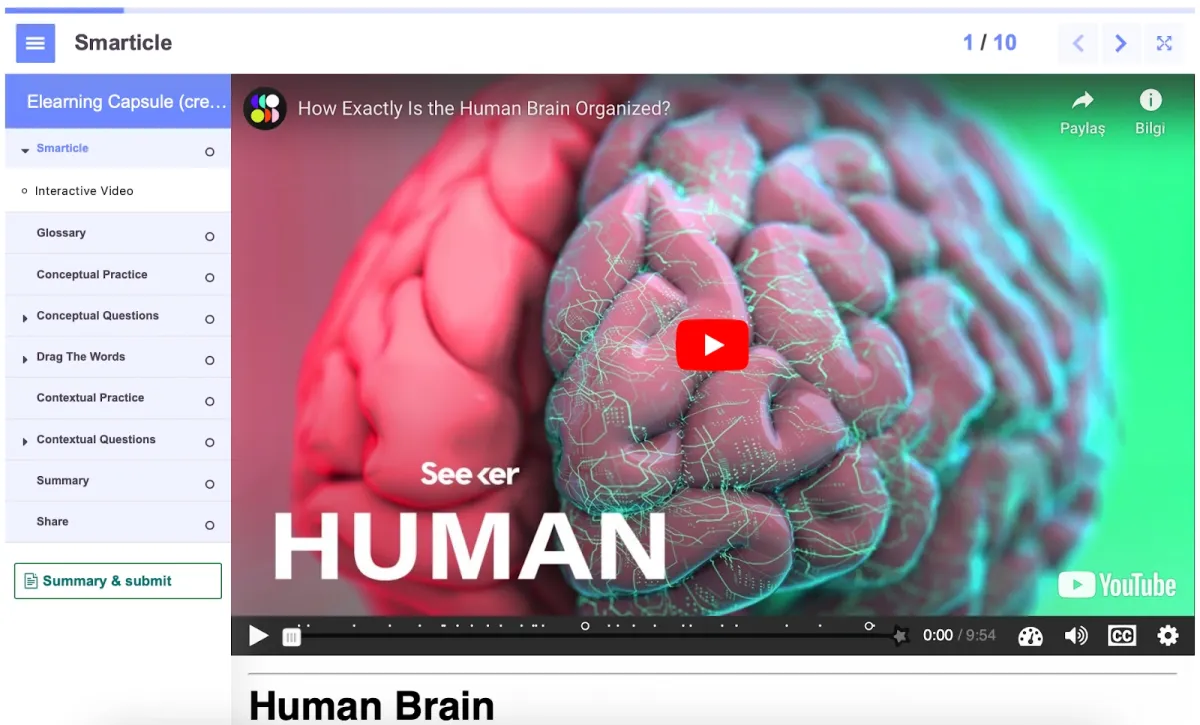
Figure 11: An example of AI-generated course content from NOLEJ.
41. Tutoring
AI-generated tutoring can allow students to interact with a virtual tutor and receive real-time feedback in the comfort of their home. This makes it an ideal solution for those children who may not have access to traditional face-to-face education.
Real-life example: Khan Academy leverages GPT-4 in its AI assistant, Khanmigo, and it serves as a virtual tutor for students and an support for teachers by addressing different educational needs.
Khanmigo facilitates deeper learning by asking individualized questions and contextualizing content relevance. Early results show promise in improving student engagement and learning outcomes. Khanmigo also helps teachers create instructional materials and tailor learning experiences (See Figure below).
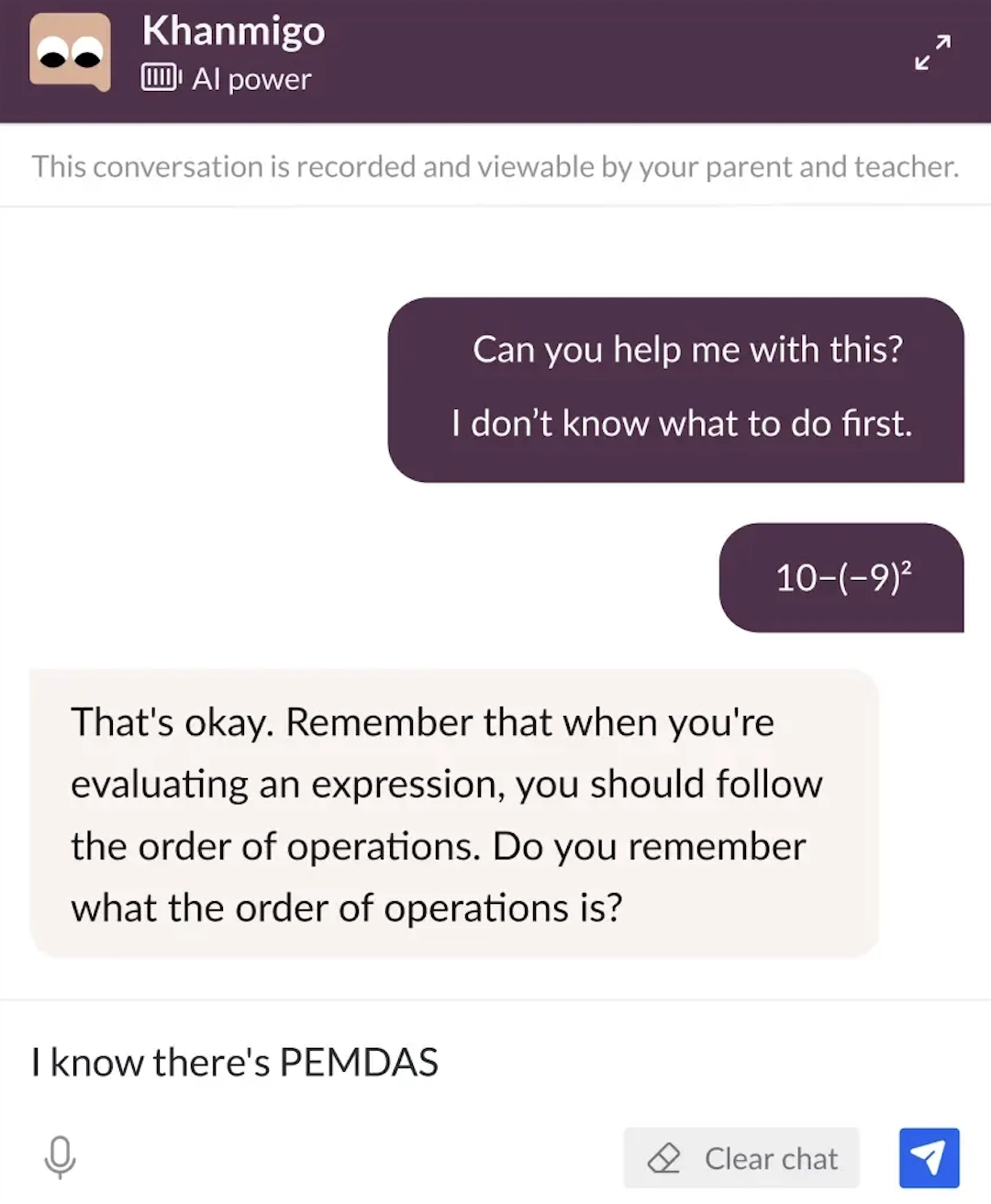
Figure 12: Khan Academy’s Khanmigo personalized question generation for deeper learning.22
Real-life example:
A study conducted in Nigeria evaluated the impact of generative AI on student learning outcomes in secondary education. The intervention involved using Microsoft Copilot, powered by GPT-4, as a virtual tutor for English language instruction in a six-week after-school program. The study employed a randomized controlled trial across nine public schools.
The results indicate that students who participated in the program experienced statistically significant improvements in English proficiency, digital literacy, and knowledge of artificial intelligence.
The approach combined AI-driven tutoring with teacher oversight and curriculum alignment. The study also found the program to be cost-effective in comparison to traditional interventions.
These findings suggest that generative AI, when integrated into structured educational programs, may offer a viable method to support learning in contexts with limited educational resources.23
42. Data privacy protection for analytical models
One advantage of using generative AI to create training data sets is that it can help protect student privacy. A data breach or hacking incident can reveal real-world data containing personal information about school-age children.
Using synthetic data, which is created by AI models that have learned from real-world data, can provide anonymity and protect students’ personal information. Synthetic data sets produced by generative models are effective and useful for training other algorithms, while being secure and safe to use.
43. Restoring old learning materials
Generative AI can improve the quality of outdated or low-quality learning materials, such as historical documents, photographs, and films.
By using AI to enhance the resolution of these materials, they can be brought up to modern standards and be more engaging for students who are used to high-quality media.
> Fashion Applications
44. Creative designing for fashion designers
From creating innovative styles to refining and optimizing existing looks, the technology helps designers keep up with the latest trends while maintaining their creativity in the process. This can be done by a variety of techniques such as unique generative design or style transfer from other sources.
Real-life example: ClothingGAN is an AI tool designed to generate creative garment designs. The platform utilizes GitHub’s resources and allows designers to create innovative and unique designs efficiently (See Figure below).

Figure 13: Garments generated by ClothingGAN.
45. Turning sketches into color images
Utilizing Generative AI, the fashion industry can save both precious time and resources by quickly transforming sketches into vibrant pictures.
46. Generating representative fashion models
By leveraging generative AI to create a variety of fashion models, fashion companies can better serve their diverse customer base and accurately display their products in a more authentic manner. They can use such models for virtual try-on options for customers or 3D rendering of a garment.
47. Marketing & Trend Analysis for Fashion Brands
Generative AI can help trend analysis in fashion by:
- Bringing together a variety of techniques, such as machine learning and probabilistic programming. These techniques allow for powerful generative models that consider the customer desires in the fashion business.
- Generating deeply personalized options for specific consumer desires that go beyond what traditional analytics and customer demand algorithms can do.
It also improves fashion marketing capabilities by:
- Utilizing data analysis, natural language processing and machine learning to create a highly tailored and personalized product range for the target audience
- Designing emails, website pages, captions, and ads that are tailored to a specific person’s interests and preferences in order to engage them
- Plotting creative and authentic marketing and ad content that are likely to storm search results
48. Cosmetics with generative AI:
Many companies in the cosmetics industry are leveraging generative AI, one of which is altering perfume development by automating formulation, reducing production time, and changing how scents are designed and evaluated.
Companies like Osmo utilize machine learning to analyze odor molecules and generate custom fragrances in under 48 hours, thereby bypassing the traditional months-long process that involves raw material aging and manual compounding.
Major industry players, including Givaudan, DSM-Firmenich, IFF, and Symrise, integrate AI into regulatory checks, ingredient selection, and scent optimization.24
For more on how generative AI see: Generative AI use cases in fashion.
> Banking Applications
49. Fraud detection
Generative AI provides banks with a powerful tool to detect suspicious or fraudulent transactions, enhancing the ability to combat financial crime. Training GANs for the purpose of fraud detection, by utilizing it with a training set of fraudulent transactions, helps identify underrepresented transactions.
Real-life example: Stripe integrated OpenAI’s GPT-4 to improve its ability to detect malicious activities and understand user needs by analyzing vast amounts of data, resulting in more tailored and accurate responses to customer inquiries.
By analyzing the syntax of Discord posts, GPT-4 flags suspicious accounts for Stripe’s fraud team to investigate. GPT-4 also scans inbound communications to identify coordinated malicious activity to support Stripe’s ability to manage fraud.
The integration of GPT-4 has improved Stripe’s operational efficiency with more personalized customer support and advanced fraud detection capabilities to maintain a secure platform.25
50. Risk management
By leveraging GANs, it is possible to compute value-at-risk estimations that display the potential amount of loss in certain periods or build economic scenarios for forecasting financial markets.
GANs also aid in understanding volatility by generating new and assumption-free situations founded on historical data trends.
51. Generating user-friendly explanations for loan denial
Decision makers and loan applicants need to understand the explanations of AI-based decisions, including why the loan applications were denied. A conditional GAN is a useful tool to create applicant-friendly denial explanations as in the figure below.
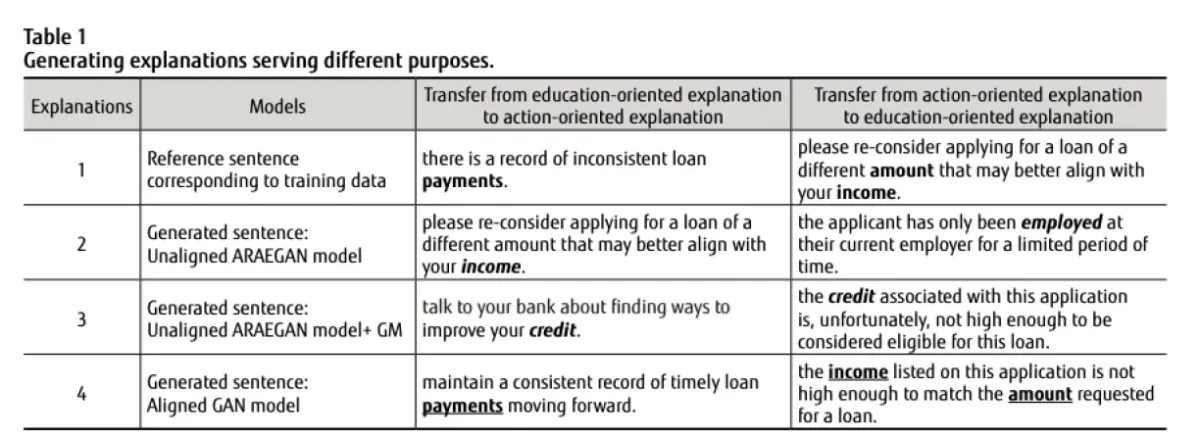
Figure 14: Generating User-Friendly Explanations for Loan Denials Using Generative Adversarial Networks.26
52. Data privacy protection
Synthetic AI-generated data can help banks navigate data privacy challenges by creating shareable and privacy-compliant datasets ideal for training models in credit assessment.
For more, you can check out:
> Gaming Applications
53. Procedural content generation
Generative AI can generate game content, such as levels, maps, and quests, based on predefined rules and criteria. This can help game developers to create more varied and interesting game experiences.
Real-life example: Ubisoft leveraged generative AI to create the non-playable characters (NPCs) in Watch Dogs: Legion.
Each character in the game was uniquely designed with distinct appearances, behaviors, and backgrounds. This process increased the realism and immersion of the game while making the player experience more dynamic and engaging.
54. Player behavior analysis
It can be used to analyze player data, such as gameplay patterns and preferences, to provide personalized game experiences. This can help game developers to increase player engagement and retention.
55. Non-player character (NPC) behavior
Generative AI can create realistic and dynamic NPC behavior, such as enemy AI and NPC interactions. This can help game developers to create more immersive and challenging game worlds.
56. User interface design
Generative AI can design user interfaces that are intuitive and user-friendly. This can help game developers to improve the player experience and increase player engagement.
57. Game testing
Generative programming tools can be used to automate game testing, such as identifying bugs and glitches, and providing feedback on gameplay balance. This can help game developers to reduce testing time and costs, and improve the overall quality of their games.
> Travel Applications
58. Identity verification
Generative AI in face identification and verification systems at airports can aid in passenger identification and authentication. This is accomplished by generating a comprehensive image of a passenger’s face utilizing photographs captured from various angles, streamlining the process of identifying and confirming the identity of travelers.
Real-life example: Allpass.ai developed a mobile tool that transforms smartphones into contactless ID scanners to make check-ins faster and travel processes more convenient.
This solution also integrates biometric verification and fraud detection, improving security by leveraging a global database of identity documents.
59. Personalized travel and destination recommendations
Generative AI can analyze customer data, such as past bookings and preferences, to provide personalized recommendations for travel destinations, accommodations, and activities.
> Retail Applications
60. Product recommendations
Using generative models, AI in retail tools can suggest new or alternative products to customers that they might be interested in, based on their buying history and preferences. It can also anticipate their future needs and preferences, thereby improving the shopping experience.
Real-life example: Adoric offers a tool that helps websites show product recommendations at various points in the customer journey, such as on the homepage or during checkout.
The tool uses advanced features such as Audience Targeting and Campaign Triggers to optimize customer engagement based on factors such as location and traffic source.
61. Product and display design
Generative AI can create new product designs based on the analysis of current market trends, consumer preferences, and historic sales data. The AI model can generate multiple variations, allowing companies to shortlist the most appealing options.
For instance, creating designs for clothing, furniture, or electronics can be an option. Or personalizing the display options according to customer choice is another option.
62. Automated retail content generation
Retailers can use AI to create product descriptions, social media promotional content, blog posts, and other content that improves SEO and drives customer engagement.
63. Inventory management & supply chain optimization
Generative AI can help forecast demand for products, generating predictions based on historical sales data, trends, seasonality, and other factors. This can improve inventory management, reducing instances of overstock or stockouts.
64. Virtual shopping assistants
Generative AI can power conversational virtual assistants that help customers in their shopping journey, generating responses to their queries and guiding them through the purchasing process.
> Insurance Applications
65. Policy documentation
Generative AI in insurance tools can help generate policy documents based on user-specific details. It can automatically fill in the information where necessary, speeding up the process of creating these documents.
Real-life example: Lemonade Insurance implemented AI and chatbot technology, known as Maya, to manage its insurance offerings.
Lemonade’s Maya interacts with customers in real time, collects information, and generates policy documents instantly to manage the process for renters and homeowners insurance applications.
66. Risk assessment and premium calculation
Generative AI can be used to simulate different risk scenarios based on historical data and calculate the premium accordingly.
For example, by learning from previous customer data, generative models can produce simulations of potential future customer data and their potential risks. These simulations can be used to train predictive models to better estimate risk and set insurance premiums.
67. Fraud detection
Generative AI can generate examples of fraudulent and non-fraudulent claims, which can be used to train machine learning models to detect fraud. These models can predict if a new claim has a high chance of being fraudulent, thereby saving the company money.
For more, explore Fraud detection in insurance.
68. Customer profiling
Generative AI can be used to generate synthetic customer profiles, which can help in developing and testing models for customer segmentation, behavior prediction, and personalized marketing without breaching privacy norms.
69. Claims processing
Generative AI models can be employed to streamline the often complex process of claims management. They can generate automated responses for basic claim inquiries, accelerating the overall claim settlement process and shortening the time of processing insurance claims.
70. Policy generation
Generative AI models can generate personalized insurance policies based on the specific needs and circumstances of each customer.
Based on data about the customer, such as age, health history, location, and more, the AI system can generate a policy that fits those individual attributes, rather than providing a one-size-fits-all policy.
71. Predictive analysis & scenario modeling
Generative AI models can generate thousands of potential scenarios from historical trends and data. The insurance companies can use these scenarios to understand potential future outcomes and make better decisions.
> Manufacturing Applications
72. Predictive maintenance
By using machine learning algorithms, manufacturers can predict equipment failures and maintain their equipment proactively. These models can be trained on data from the machines themselves, like temperature, vibration, sound, etc.
As these models learn this data management, they can generate predictions about potential failures, allowing for preventative maintenance and reducing downtime.
Real-life example: BlueScope collaborated with Siemens to leverage Senseye’s Predictive Maintenance platform to address operational downtime in its production lines.
Through IoT-based monitoring of machinery, BlueScope detected equipment failures earlier, which helped reduce resource waste and improved production efficiency.
73. Quality control
AI can help improve quality control processes in manufacturing. By learning from images of past products and identifying defective ones, generative AI tools can generate a model to predict whether a newly manufactured product is likely to be defective.
74. Production planning and inventory management
Generative AI models can simulate various production scenarios, predict demand, and help optimize inventory levels. It can use historical customer data to predict demand, thereby enabling more accurate production schedules and optimal inventory levels.
Business function specific GenAI Applications
> Customer Service Applications
75. Personalized customer responses
Conversational generative AI tools can be trained on customer data, such as past purchases, chat history, and customer feedback to create a personalized profile for each customer. When a customer sends a message, ChatGPT or other similar tools can use this profile to provide relevant responses tailored to the customer’s specific needs and preferences.
Real-life example: During the COVID-19 pandemic, Banc Sabadell partnered with Zendesk to implement an AI-powered chat system.
This virtual assistant helped manage the surge in customer inquiries by providing self-service options for common questions and routing more complex issues to human agents for resolution.
76. Multilingual customer support
The multilingual support offered by generative AI tools like ChatGPT for customer service involves using the system’s large language model capabilities to provide support to customers who speak different languages. Conversational AI tools can be trained on a variety of languages and can translate messages from one language to another in real time.
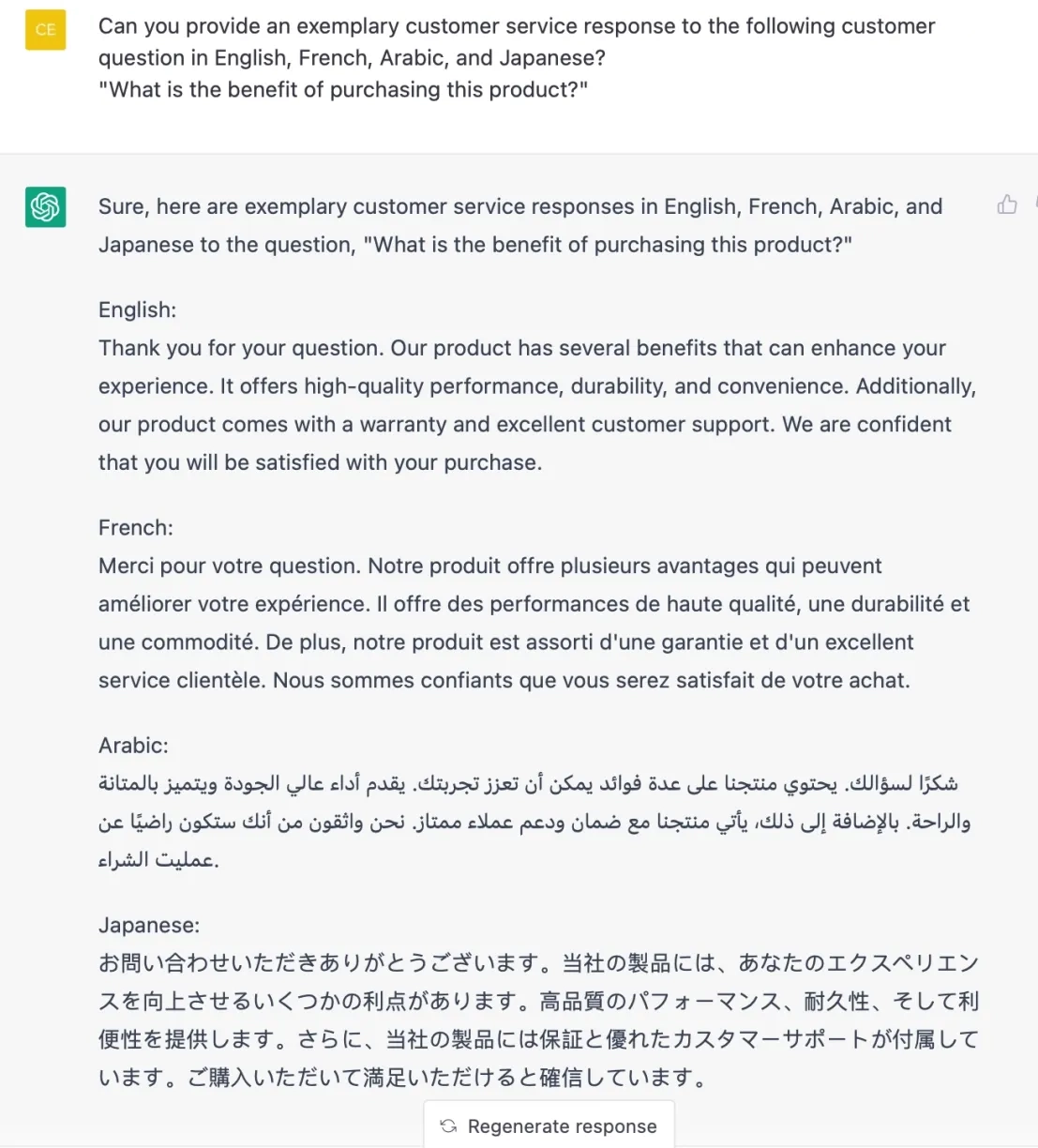
Figure 15: An exemplary multilingual customer response generated by ChatGPT. Discover the diverse business applications of ChatGPT.
77. Quick responses to customer inquiries & complaints
Conversational tools can be trained to recognize and respond to common customer complaints, such as issues with product quality, shipping delays, or billing errors.
When a customer sends a message with a complaint, the tool can analyze the message and provide a response that addresses the customer’s concerns and offers potential solutions.
Real-life example: ServiceNow’s GenAI has increased employee self-service by 14% and customer self-service by 10%, by allowing users to intuitively find answers on their own with its self-service function. This shift reduces the load on help desks, enabling agents to focus more on engaging tasks and providing users with timely solutions.
The ServiceNow DT team has saved $5.5 million annually through this method, with 54% ITSM issue deflection rate and Now Support achieving nearly 20% case avoidance. This approach ensures quick resolutions and enhances satisfaction, as 56% of customers report positive experiences with AI-summarized solutions.27
78. Creating customer emails
Tools like ChatGPT can create personalized email templates for individual customers with given customer information. When the company wants to send an email to a customer, ChatGPT can use a template to generate an email that is tailored to the customer’s individual preferences and needs.
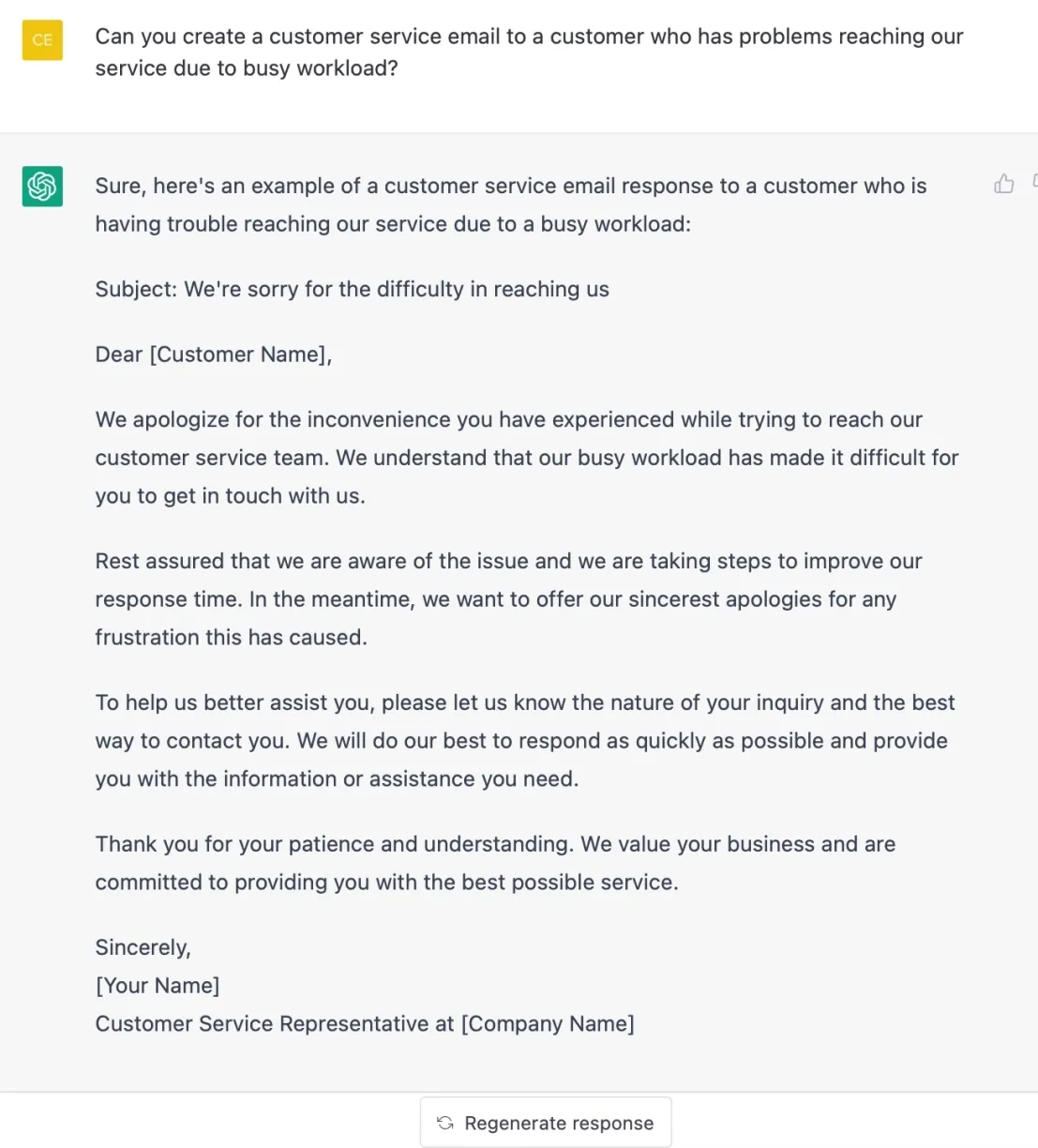
Figure 16: ChatGPT provides an email template for a certain customer problem.
79. Replying to customer reviews
When a customer leaves a review or comment on online review platforms or your website, ChatGPT or other tools can generate a response that addresses the customer’s concerns and offers potential solutions or assistance.
80. Answering FAQs
For example, ChatGPT can be trained on a company’s FAQ page or knowledge base to recognize and respond to common customer questions. When a customer sends a message with a question, ChatGPT can analyze the message and provide a response that answers the customer’s question or directs them to additional resources.
> Finance Applications
Finance teams deal with semi-structured data, which can be queried using generative AI solutions:
- AP automation / invoice processing: Generative AI solutions go beyond extracting key-value pairs from documents and allow users to query documents in a flexible manner, helping unlock automation for more complex documents.
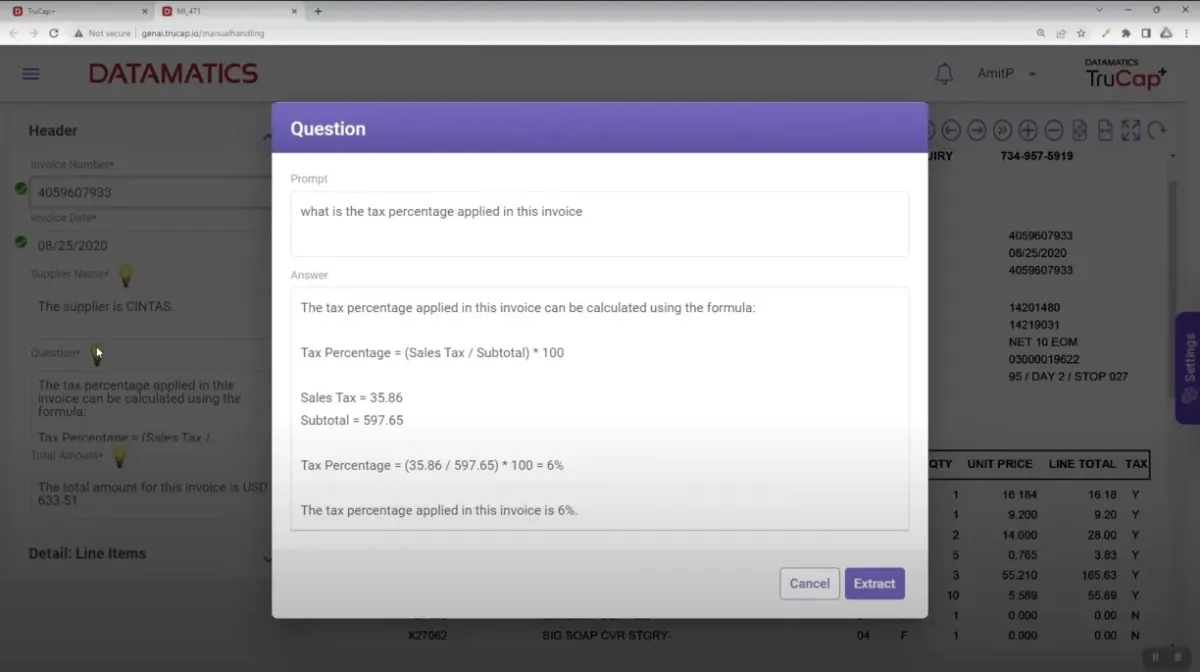
Figure 17: Invoice processing with generative AI.28
AP teams don’t need to switch their systems of record like ERP to take advantage of such technologies, their ERP can be enriched via plugins as outlined here:
Real-life example: BBVA, Spain’s second-largest bank, collaborated with OpenAI to acquire 3,000 ChatGPT Enterprise licenses. ChatGPT Enterprise, a business-oriented version of ChatGPT, enables employees to create customized “GPTs” tailored to specific tasks or workflows.
BBVA staff across departments such as legal, risk, marketing, talent, and finance have developed over 2,900 GPTs. These tools perform various functions such as interpreting risk-related terminology like “write-off” to drafting responses to inquiries from retail banking clients.
BBVA reported that early adopters have experienced an increase in productivity, with 80% of users stating that the tools save them more than two hours per week. However, concerns about measurable bottom-line impacts and the challenges of scaling the technology is still ongoing. The company highlighted the difficulties of integrating ChatGPT Enterprise with complex internal systems and databases.
The bank has since expanded to 3,300 licenses and plans further growth in 2025.29
For more, see AI applications in accounts payable.
> Marketing Applications
81. Content creation for marketing
Generative AI tools enable businesses to create personalized content such as product descriptions, social media posts, video ads and email campaigns.
A recent study of over three years of research found that human-AI synergy is more likely in creative tasks than decision-based ones. In creative work like content creation, AI complements human creativity by handling repetitive tasks, while humans provide the insight and originality.30
For example, AI tools can generate headlines, structure articles, and suggest calls to action, while marketers refine messaging and ensure brand consistency. This collaboration increases efficiency without losing the creative touch that engages audiences. As AI evolves, businesses should focus on strategically integrating AI into content workflows, rather than automating creative processes entirely.
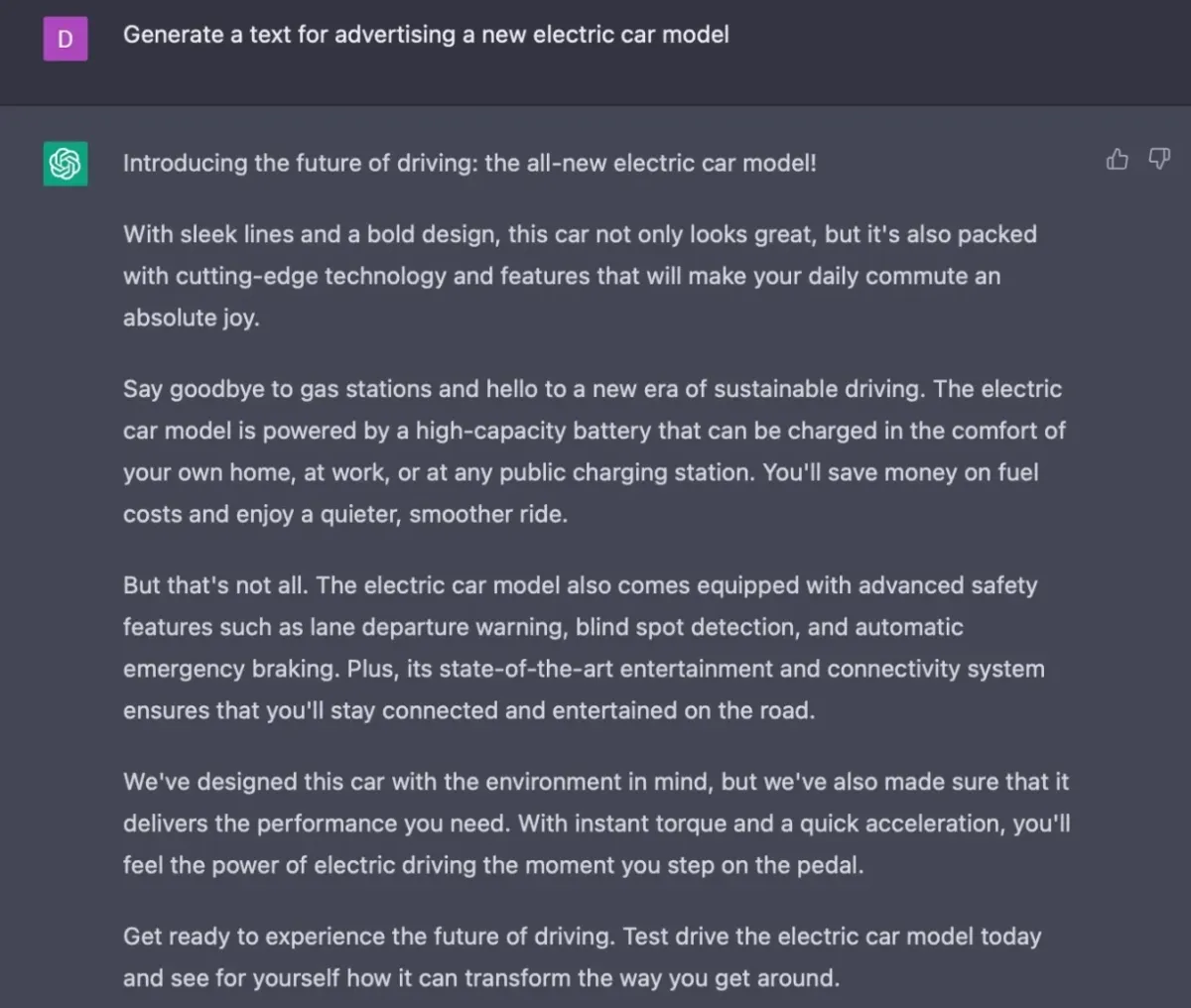
Figure 18: AI-generated content for advertising a new electric car model by using ChatGPT.
Real-life example: Typeface utilizes generative AI to help professionals create unique and brand-aligned content efficiently. Powered by Microsoft Azure OpenAI Service and Azure Machine Learning, Typeface allows brands like Vasanti Cosmetics to produce 10 times more content while preserving their unique voice and visual identity.
This AI-driven solution quickly learns a brand’s style from various inputs and offers customizable templates for instant image and copy creation. As a result, Typeface helps reduce manual content generation processes and increase efficiency and creativity for marketing materials.31
Explore how to use generative AI in content creation, specifically copywriting.
82. Personalized customer experience
ChatGPT and other similar generative tools with their natural language processing (NLP) can generate personalized content for your customers based on their preferences, past behavior, and demographics. This can help you create targeted content that resonates with your audience, which can lead to higher engagement and conversion rates.
Check out conversational AI for sales to discover how it enhances customer interactions
83. Audience research
Generative AI can be used to analyze customer data such as:
- Search queries
- Social media interactions
- Past purchases to identify patterns and trends in customer behavior.
By analyzing this data, generative AI tools can help you identify your target audience’s preferences, interests, and pain points. This information can inform your marketing messaging, content, and product development.
84. Writing product descriptions
Product descriptions play a crucial role in marketing, as they provide potential customers with detailed information about a product’s features, benefits, and value. Generative tools like ChatGPT can help create compelling and informative product descriptions that resonate with your target audience.
85. Creating customer surveys
Surveys are an effective way to gather feedback and insights from customers, which can help marketers improve their products, services, and marketing strategies. Here are some ways that generative AI can help with creating customer surveys:
- Question generation
- Organizing survey structure
- Making surveys multilingual with its translation ability
- Survey analysis
86. Generating video ads or product demos
Video generation application of generative AI can be useful for marketing in:
- Video ads: With generative AI, businesses can create high-quality video ads that can be used on various platforms, including social media and video sharing sites. This can help to increase brand awareness and drive conversions.
- Product demos: Video generation can also be used to create product demo videos. By using generative AI to create these videos, businesses can showcase their products in a visually appealing way, which can help to increase engagement and sales.
Email marketing campaigns
Leveraging generative AI for email marketing supports marketing processes by streamlining automation, increasing personalization, and creativity with engaging content generation.
Generative AI tools can be utilized to generate personalized:
87. Email text
88. Subject lines
89. Images within the email body
90. Call-to-actions (CTAs).
AI email marketing tools can also enable businesses to:
91. Automate email responses
92. Select target audience
93. Optimize email delivery times
SEO Applications
94. Generating topic ideas for content writing
Generative tools like ChatGPT can be used for generating topic ideas for SEO content writing by utilizing its language processing capabilities to:
- produce relevant keywords and phrases
- analyze competitors’ content to identify gaps in coverage
- suggest topics based on current trends and user search queries
95. Conducting keyword research
The process of including related keywords to a content is crucial for a successful SEO strategy as it helps determine the terms and phrases that potential customers use when searching for products or services related to the website’s offerings.
Generative tools like ChatGPT can perform functions in keyword search optimization such as:
- Generating keywords: It can generate a list of relevant keywords for a topic or theme by analyzing the context and language used in the provided information.
- Identifying keyword trends: It can analyze search data to identify current keyword trends and suggest terms that are likely to be popular in the near future.
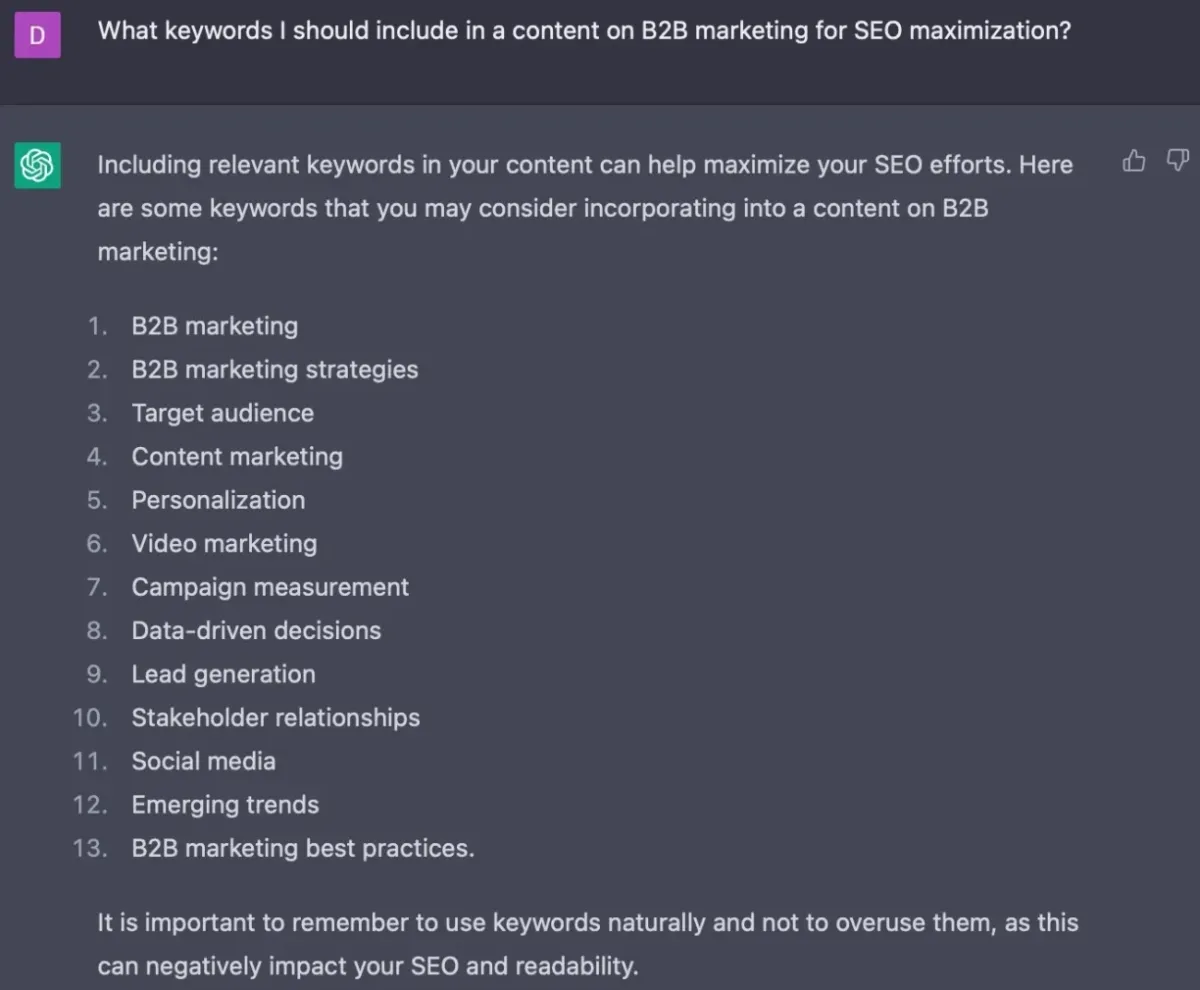
Figure 19: Generating keyword ideas for B2B marketing content with ChatGPT.
96. Finding the right titles
Generative tools like ChatGPT can generate SEO-friendly titles by ensuring that the titles are:
- descriptive and clearly convey the topic of the content
- capable of incorporating relevant keywords that are related to the topic
- concise and to the point, typically falling within the 60-70 character limit for optimal display in search engine results pages.
- eye-catching and likely to attract clicks, which can help improve click-through rate (CTR) and ultimately, SEO
97. Grouping search intent
Understanding the search intent behind a query is crucial in creating content that accurately and effectively addresses the needs of the customers, which can lead to higher engagement and conversions.
Tools like ChatGPT can assist in search intent grouping by analyzing search queries and categorizing them based on the user’s intended goal or purpose, thanks to Natural Language Processing (NLP) methods. This can help businesses and marketers understand the intent behind specific search terms and optimize their content and strategies to better meet the needs and expectations of their target audience.
98. Creating content structure
Tools like ChatGPT can assist in creating content structure by generating outlines and organization suggestions for a given topic. This can be useful for SEO maximization because well-structured and organized content not only provides a better user experience but also helps search engines understand the context and relevance of the content.
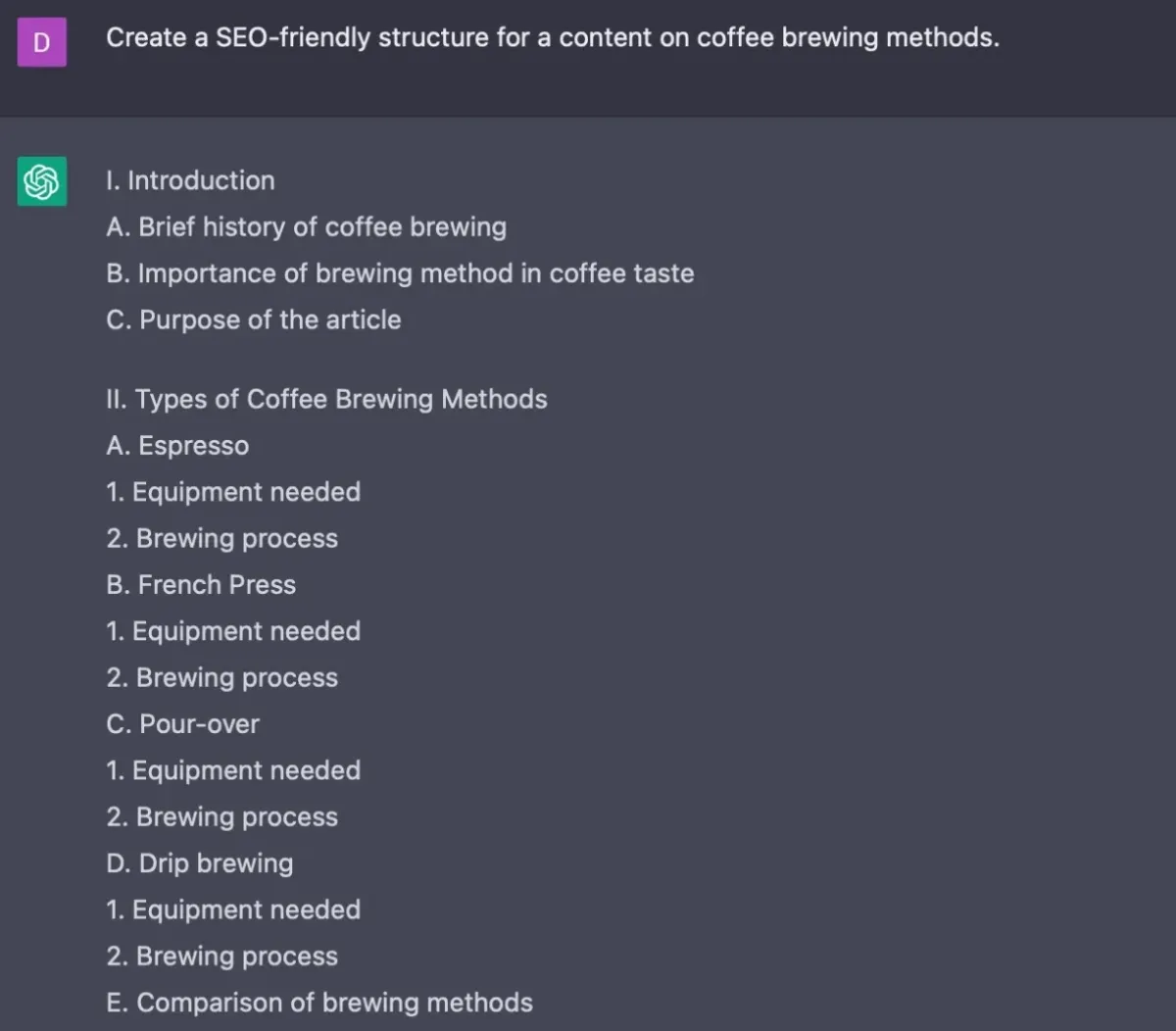
Figure 20: ChatGPT creates the structure of a content.
99. Generating meta descriptions
A meta description is an HTML attribute that provides a brief summary of a web page’s content. The meta description serves as an advertisement for the page, encouraging users to click on the link and visit the page. Therefore, meta descriptions are an important element in SEO.
ChatGPT can be used to create effective meta descriptions by generating summaries of the content that accurately and concisely describe the main topic of a page.
100. Creating sitemap codes
A sitemap is a structured XML file that lists all a website’s pages and content. It helps search engines understand the structure and organization of a website. The sitemap code provides information about each page, such as its URL, the date it was last modified, and its priority relative to other pages on the site.
ChatGPT can be used to generate sitemap codes, producing an XML file that lists all the pages and content on a website.
> HR Applications
101. Job description generation
Generative AI can be used to create job descriptions that accurately reflect the required skills and qualifications for a particular position.
Real-life example: To process and retrieve relevant resumes based on natural language job descriptions, DataToBiz developed an AI-powered resume filter. Using semantic search and large language models (LLMs), resume filtering enabled interpretation and matching job descriptions with resumes. The system enhanced user queries, indexed resumes, and provided contextually accurate results.
The solution also improved user satisfaction, optimized operational efficiency, and enabled strategic talent acquisition, which would result in quicker and more accurate candidate selection.32
102. Creating interview questions
HR departments often need to develop a set of questions to ask job candidates during the interview process, which can be time-consuming. AI can generate interview questions that are relevant to the job position and that assess the candidate’s qualifications, skills, and experience.
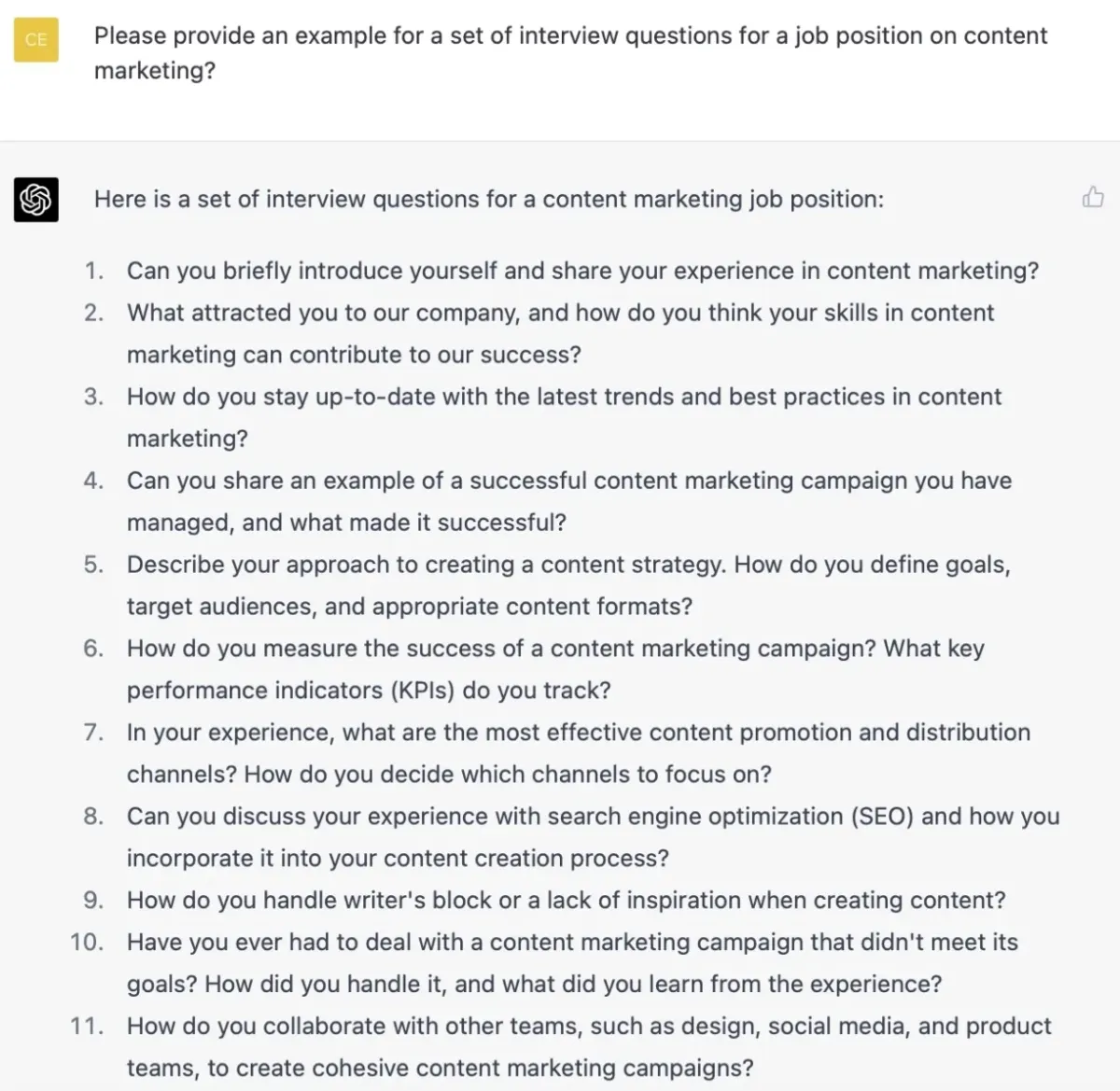
Figure 21: ChatGPT creates a set of interview questions for a job position.
103. Generating onboarding materials
AI can generate onboarding materials for new employees, such as training videos, handbooks, and other documentation.
104. Employee support with AI chatbots
Leveraging AI tools can enhance employee satisfaction by simplifying access to information and automating routine HR processes. These systems support HR agents to efficiently manage tasks such as:
- addressing frequently asked questions,
- processing time-off requests,
- managing payroll, and
- overseeing benefits like healthcare, retirement plans, and career development opportunities.
Real-life example: IBM HR agents leverage a comprehensive library of prebuilt conversational AI automations, referred to as “skill-flows.” These automations help manage complex HR tasks while ensuring compliance with regulations and company policies. It also provides employees with a self-service chat experience powered by natural language.33
105. Increase workplace productivity
Large enterprises face a persistent challenge in optimizing the time of knowledge workers, as significant effort is spent on routine tasks such as email and meeting preparation, rather than on core responsibilities.
A six-month field experiment using Microsoft 365 Copilot demonstrated that generative AI can reduce the time spent on emails by 25%, accelerate document completion, and increase focus time, all without disrupting team workflows or meeting structures.
The most notable improvements occurred in tasks that workers could adjust independently, highlighting early productivity gains but also underscoring the need for broader organizational changes to realize full AI-driven transformation.34
> Supply Chain & Procurement Applications
106. Demand forecasting and supply chain management
Generative AI can help businesses predict demand for specific products and services to optimize their supply chain operations accordingly. This can help businesses reduce inventory costs, improve order fulfillment times, and reduce waste and overstocking.
Explore how generative AI transforms supply chain operations by predicting demand and optimizing processes. Dive into the details of Gen AI in supply chain.
Real-life example: FLO, a footwear retailer, partnered with Invent Analytics to improve its omni-channel inventory management.
Invent Analytics’ forecasting solutions helped FLO reduce lost sales by 12%, optimize stock levels, and increase net profit by 4.7%. This collaboration also provided more accurate inventory distribution across their network.
107. Inventory management with AI chatbots
AI chatbots can manage procurement processes by automating tasks such as monitoring inventory levels, reordering goods, and tracking orders in real-time. They also improve decision-making through demand forecasting, product categorization, and providing real-time inventory updates. Here are the benefits of leveraging AI chatbots for inventory management:
- Automated procurement: AI chatbots can reorder items automatically based on stock thresholds.
- Inventory tracking: Provide real-time updates on stock levels and order statuses.
- Customer support: Handle inquiries about product availability and order details.
- Improved categorization: Use machine learning to better classify and suggest products.
108. Transportation and routing
Generative AI can greatly enhance transportation and routing in supply chain management. By processing large volumes of data from multiple sources, it can create optimized transport plans, saving time and boosting logistics efficiency.
Key benefits include:
- Cost-effective route planning and on-time deliveries.
- Smarter vehicle and fleet management with better resource use and reduced wear.
- Adaptive routing that responds to disruptions and delays.
> Legal Applications
109. Contract generation
Generative AI can generate contracts based on pre-defined templates and criteria. This can save procurement departments time and effort and help ensure consistency and accuracy in contract language.
Real-life example: Orangetheory worked with Ironclad to automate its contract management processes and leverage AI Assist to manage over 1,000 contract templates across its franchise network.
This collaboration reduced project timelines from six months to three and improved the customer experience with digital contract solutions.
110. Contract compliance
Companies have thousands of contracts with various negotiated terms. LLMs or generative AI applications with language understanding capabilities can:
- Categorize contracts
- Identify common terms
- Highlight unique or rare terms
111. Legal chatbots
Generative AI enables chatbots to deliver basic legal guidance by interpreting user queries and providing clear, accurate answers. These chatbots can assist with common legal questions—like tenant rights or contract basics—and help users prepare simple legal documents through guided prompts.
They can also direct users to the right resources, such as legal aid services or government portals, based on the issue at hand. By automating early legal support, AI-powered chatbots make legal assistance more accessible, particularly for individuals who may face cost or accessibility barriers.
> Sales Applications
112. Sales video generation
Generative AI can be used to create personalized sales videos tailored specifically to the respected customer’s needs and expectations. These personalized sales videos enable sales reps to individually address sales goals, increase personal relationships with the customers and generate more leads. Check out sales video software to learn more about sales video generation.
Real-life example: Xerox partnered with Synthesia’s AI video platform to cut down on video production costs by 50% and reduce the time needed to create training content by 30%.
The platform also allowed Xerox to localize training materials for its global workforce while improving engagement and knowledge retention for over 1,000 sales reps.
Explore statistical insights derived from generative AI applications in various business functions.
113. Sales coaching
Generative AI can be used to provide personalized sales coaching to individual sales reps, based on their performance data and learning style. This can help sales teams improve their skills and performance and increase sales productivity.
114. Sales forecasting and pipeline optimization
Generative AI can analyze historical sales data and generate forecasts for future sales. So, sales teams can optimize their sales pipeline and allocate resources more effectively.
115. Lead identification and qualification
AI can be used to identify potential sales leads based on customer data and behavior, and qualify leads based on their likelihood to convert. Also, it can generate customized sales tactics and campaigns for generating leads.
> Audit Applications
116. Audit reporting automation
Manual processes, such as reporting, could be time-consuming and error-prone. Generative models like ChatGPT can help auditors automate repetitive tasks, such as paperwork and reports. Specifically, they can produce standardized reports (such as the figure below) that offer consistency in how findings are presented.

Figure 22: Generating audit reports with OpenAI’s ChatGPT.
Real-life example: KPMG collaborated with MindBridge to leverage AI for analyzing financial data and automating audit processes.
This partnership increased the accuracy and efficiency of audits by using AI to detect anomalies and flag risky transactions. It enabled KPMG to provide more reliable financial insights to its clients.
117. Data analysis of documents
Audit programs involve the frequent analysis of large swaths of financial and operational data.
ChatGPT can automate some of these data analysis duties, such as in:
- Performing computations
- Aggregations
- Dataset comparisons
118. Real-time risk monitoring
Generative AI tools can also be helpful in real-time risk monitoring. Auditors can interact with the model to discuss the organization’s activities, control systems, and business environment.
ChatGPT, for example, can assist auditors in assessing risk levels, identifying priority areas for further investigation, and gaining insights into potential hazards.
119. Pattern recognition and anomaly detection
Generative AI can help auditors to spot and flag audit abnormalities for further examination. When incorporated with human evaluation correctly, generative AI tools can be useful in identifying potential fraud and enhancing internal audit functions.
Auditors can use generative AI models’ natural language processing capabilities to reveal potential risks that might be difficult to identify manually by feeding it relevant data and asking it to look for odd or unexpected patterns.
120. Training auditors
In audit, ChatGPT can train auditors by offering them expertise, explanations, and examples that are relevant to their jobs. It can offer educational materials such as:
- Conceptual knowledge
- Case studies
For more, check out Generative AI for audit.
> Research&Development (R&D) Applications
121. Team collaboration for R&D teams
Generative AI can function as a collaborative teammate in high-level decision-making and problem-solving. By offering suggestions, evaluating trade-offs, and synthesizing cross-domain knowledge, AI tools can enhance interdisciplinary teamwork.
Real-life example: A study was conducted with 776 professionals at Procter & Gamble to assess the impact of AI, specifically GPT-4, on teamwork and individual performance in product development tasks.35 Key findings from the study include:
- Performance enhancement: Individuals assisted by AI performed on par with traditional two-person teams without AI, indicating that AI can replicate the benefits of human collaboration. Teams utilizing AI showed the highest performance levels, particularly in producing top-quality solutions.
- Expertise integration: AI assistance enabled both commercial and R&D professionals to develop balanced solutions that integrated technical and market perspectives, effectively bridging traditional expertise silos.
- Efficiency gains: Participants using AI completed tasks 12-16% faster than those without AI, while also generating more detailed and extensive solutions.
- Emotional impact: AI users reported increased positive emotions, such as excitement and enthusiasm, and decreased negative feelings, like anxiety and frustration, compared to their non-AI-using counterparts.
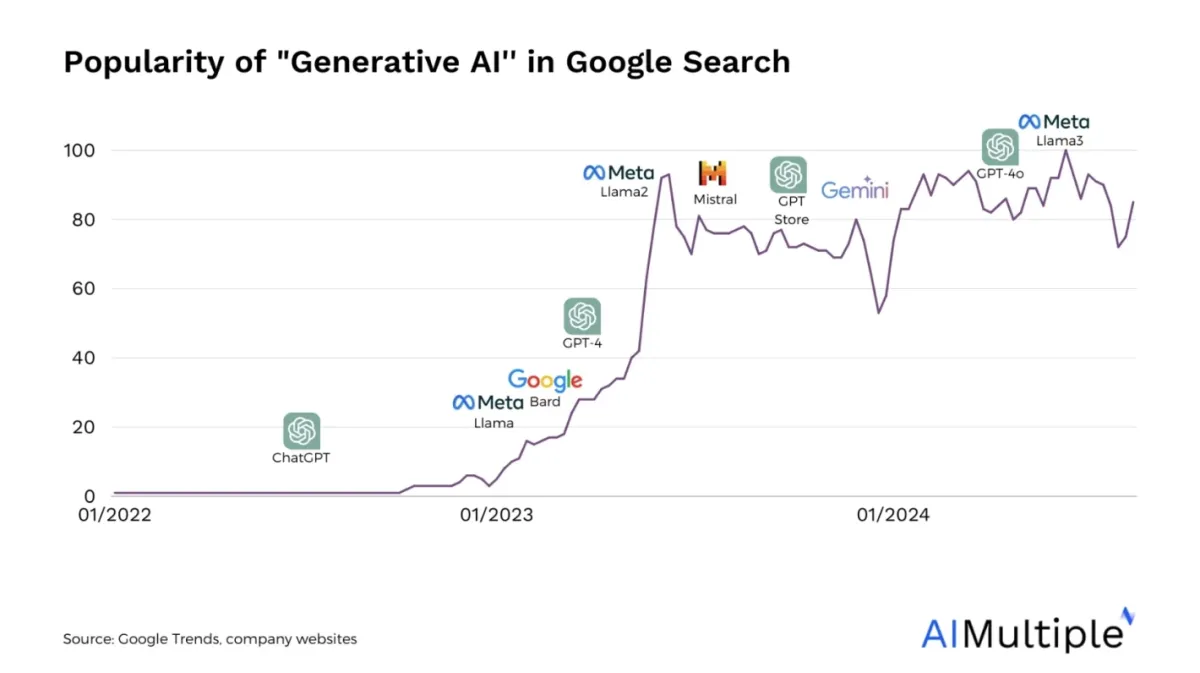
Learn more about Generative AI tools and their specific applications.
Generative AI applications with use cases and examples summary
| Domain* | Use Case | Description | Company | Real-life example |
|---|---|---|---|---|
| Video | Video Generation | Generate videos based on text input or scenarios, useful in media production. | Pictory with Lucid Dream Network | Lucid Dream Network leveraged Pictory's script-to-video tool, which provided templates and music/visual integration. This solution boosted the agency's productivity by 350% and increased social media engagement and reach by 500%. |
| Image | Image Generation | Convert text into realistic images, widely used in media, design, marketing, and more. | OpenAI with Coca Cola | In collaboration with OpenAI and Bain & Company, Coca-Cola launched the "Create Real Magic" platform. This initiative allowed users to generate unique artwork using iconic Coca-Cola brand assets, such as the contour bottle and Coca-Cola Santa Claus, through the integration of OpenAI's GPT-4 and DALL-E models. |
| Audio | Text-to-Speech Generator | Convert text to realistic speech for applications in education, marketing, and audiobooks. Thousands of books have been converted to audiobooks using text-to-speech generation technology. | Amazon Web Services (AWS) with Twilio | Polly is a cloud-based service that converts text into lifelike speech in multiple languages. By collaborating Amazon Polly, Twilio expanded its offerings by incorporating over 50 different voices and 25 languages. It also introduced new APIs that give developers advanced control over speech synthesis in their Programmable Voice applications. |
| Language | Personalized Content Creation | Generate personalized content from user preferences and interests. Can include text, images, music, or other media formats and can be applied to various areas such as social media posts, blog articles, and product recommendations. | Jasper with Akbank | By leveraging Jasper, Akbank, a commercial banking company's digital marketing team reduced content creation time by 40% and improved campaign click-through rates by up to 70%. Jasper was primarily used for crafting personalized marketing messages and push notifications. This collaboration led to a 3% increase in engagement rates while supporting Akbank’s marketing strategies and boosting customer interactions. |
| Code | Code Refactoring | Automate code refactoring from natural language descriptions. Can refactor code to improve structure, readability, and efficiency, making it easier to maintain and update over time. | Amazon Q with Ancileo | Ancileo, a SaaS solution provider for insurers and partners, leverages Amazon Q to enhance developer efficiency. By helping developers understand codebases and troubleshoot directly within their IDEs, Ancileo has reduced coding issue resolution time by 30%. Ancileo is also integrating ticketing and documentation with Amazon Q to speed up onboarding and allow team members to quickly find answers. |
| Healthcare | Personalized Medicine | Serve as medical chatbots using generative AI to interpret patient symptoms and improve diagnostic accuracy based on patient reports and test results. | BCG with Zeiss Medical Technology | The AI generates responses based on pre-approved information, ensuring accuracy in patient communication. 79% of the AI-generated responses are ready to be sent without further edits. The aim is to enhance patient engagement, allowing doctors to focus more on care, and may also contribute to increasing demand for treatments. |
| Education | Personalized Lessons | Create custom lesson plans based on student data to maximize learning outcomes. | OpenAI with Khan Academy | Khanmigo, powered by GPT-4, acts as a virtual tutor, providing personalized learning experiences for students. |
| Fashion | Creative Designing | Generate innovative fashion designs and transfer styles from other sources. | GitHub | ClothingGAN generates innovative garments, showcasing the use of generative AI in fashion design. |
| Banking | Fraud Detection | Identify suspicious financial transactions for fraud prevention. | OpenAI with Stripe | Stripe integrated GPT-4 for advanced fraud detection, improving operational efficiency and personalized customer support. |
| Gaming | Procedural Content Generation | Generate dynamic game content such as levels and quests to enhance gaming experiences. | Ubisoft | In Watch Dogs: Legion, AI is used to generate the game's population, creating characters with unique appearances, behaviors, and backstories. This PCG application contributes to the game's realism and enhances player immersion by making each character feel distinct and part of a living and dynamic world. |
| Travel | Identity Verification | Streamline passenger identification at airports by generating comprehensive face models. | Allpass.ai | Turns mobile devices into contactless ID scanners, simplifying the check-in process and increasing customer satisfaction. This enables fraud detection using a global database of identity documents and biometric verification. |
| Retail | Product Recommendation | Recommend new or alternative products to customers based on their past purchases and preferences. Can also predict future needs and interest to enhance the shopping experience by providing personalized suggestions. | Adoric | The tool allows placing recommendations on various parts of a website, like the homepage, product page, or checkout. The Audience Targeting and Campaign Trigger features help reach the right customers at the right time. Additionally, products can be shown based on factors like geolocation or traffic source, and other filters let customers refine recommendations by category and price. |
| Insurance | Policy Documentation | Automate the generation of insurance policy documents based on customer data. | Lemonade Insurance | Lemonade uses AI and chatbots to manage insurance offerings like renters and homeowners insurance. Customers provide their information through a conversational AI called Maya, which collects the necessary details to generate policy documents in real-time. |
| Manufacturing | Predictive Maintenance | Predict equipment failures and schedule maintenance to avoid costly downtime. | Siemens with BlueScope | BlueScope integrated Senseye’s Predictive Maintenance platform to address downtime issues in its line operations, which previously impacted plant throughput. The platform provided customizable reports and IoT-driven vibration monitoring for early equipment failure detection which would significantly reduce resource waste. |
| Customer Service | Responses to Customer Inquiries & Complaints | Identify and address frequent customer complaints, such as product quality issues, shipping delays, or billing mistakes. | Zendesk with Banc Sabadell | Banc Sabadell implemented a chat channel, supported by Zendesk’s AI-powered virtual assistant, to handle increased customer inquiries during the COVID-19 pandemic. The chat system enabled self-service for common queries while escalating complex issues to human agents. |
| Finance | AP Automation / Invoice Processing | Automate invoice processing and allow flexible document queries. | ReadSoft (acquired by Kofax) | ReadSoft provides automated solutions for document processing and invoice automation. Its capabilities in invoice automation helps organizations efficiently manage the entire lifecycle of receiving, processing and paying invoices, reducing manual work and improving business processes. |
| Marketing | Content Creation for Marketing | Generate text for emails, blogs, social media, and advertising copy to support marketing efforts. | Typeface with Vasanti Cosmetics | Typeface helps Vasanti Cosmetics produce 10 times more content while maintaining brand identity. |
| HR | Creating Interview Questions | Generate tailored interview questions for job candidates. | HireVue with Great Southern Bank | By collaborating with HireVue, Great Southern Bank reduced the average time-to-hire from 40 days to 23 and cut candidate screening time by 60%. This allowed the bank to handle more roles while improving candidate experience, achieving an 87% satisfaction score. The platform also enabled hiring managers to assess higher-quality candidates early in the process. |
| Supply Chain & Procurement | Demand Forecasting and Supply Chain Management | Predict demand and optimize supply chain operations for cost savings and efficiency. | Invent Analytics with FLO | FLO, a major footwear retailer, partnered with Invent Analytics to improve its inventory management across omni-channel operations. Using AI-driven forecasting, allocation, and replenishment solutions, FLO reduced lost sales by 12%, optimized stock levels, and increased net profit by 4.7%. |
| Legal | Contract Generation | Generate contracts based on templates and predefined criteria. | Ironclad with Orangetheory | Orangetheory partnered with Ironclad to streamline over 1,000 contract templates across its franchise network using AI Assist. By automating the redlining process, Orangetheory reduced project time from six months to three. The company also improved customer experience through Clickwrap for digital waivers and simplified franchise collaboration with public workflows. |
| Sales | Sales Video Generation | Create personalized sales videos tailored to the specific needs and expectations of individual customers. Also allow sales representatives to directly address customer goals to enhance personal connections, and improve lead generation. | Synthesia with Xerox | Xerox used Synthesia’s AI video platform to cut video production costs by 50% and reduce creation time by 30%. The platform allowed them to localize sales training content in multiple languages and trained over 1,000 sales reps globally. Additionally, Xerox saw higher engagement with their training videos, while improving knowledge transfer among their sales teams. |
| Audit | Audit Reporting Automation | Automate audit reports, ensuring consistency and reducing errors in audit processes. | MindBridge with KPMG | KPMG and MindBridge partnered to leverage AI to analyze financial data, flag risky transactions, and automate audit processes to increase accuracy. The collaboration allows KPMG auditors to better assess financial risks and detect anomalies, offering more precise insights for clients. |
*An industry, business function, or other area of application
Conclusion
Generative AI is rapidly expanding across industries and business functions, enabling new levels of content creation, personalization, automation, and decision-making. From creating video ads and personalized lesson plans to managing workflows in legal, HR, and finance, its applications are diverse and increasingly practical.
However, adoption requires thoughtful implementation. Accuracy, ethics, privacy, and model limitations still present challenges. While generative AI holds clear promise, success will depend on pairing these tools with human oversight, domain knowledge, and strategic integration into existing systems.
FAQ
What is generative AI?
Generative AI refers to artificial intelligence algorithms designed to create new content or data that is similar to human-generated examples. This can include text, images, music, and other types of media. These AI systems learn from a large set of existing data and then use that knowledge to generate new, original content that resembles the learned material.
What are the popular generative AI products?
GPT by OpenAI: This is an advanced language model series known for its ability to generate coherent and contextually relevant text based on given prompts. It’s used in applications like chatbots, content creation, and language translation.
DALL-E by OpenAI: A specialized AI for generating images from textual descriptions, DALL-E is known for its creativity and ability to create complex and detailed images based on specific prompts.
DeepMind’s AlphaFold: This AI system is used for predicting protein structures with remarkable accuracy, which is a significant advancement in biological research and drug discovery.
Google BERT: Although primarily a language understanding model, BERT has significantly improved the way Google’s search engine understands and processes natural language queries.
What is the difference between ChatGPT and generative AI?
ChatGPT is a specific type of generative AI. While generative AI broadly refers to AI systems that create new content, like text, images, or music, ChatGPT focuses specifically on generating human-like text based on the input it receives, often used for conversation, answering questions, and similar language-based tasks.
External Links
- 1. OpenAI is pitching Sora to Hollywood. | The Verge. The Verge
- 2. Social Media Agency Gets Higher Engagement & Reach .
- 3. DALL·E 2 | OpenAI.
- 4. Bain & Company announces services alliance with OpenAI to help enterprise clients identify and realize the full potential and maximum value of AI | Bain & Company.
- 5. “Generating Synthetic Space Allocation Probability Layouts Based on Trained Conditional-GANs”
- 6. SP-GAN: sphere-guided 3D shape generation and manipulation
- 7. [2309.03926] Large-Scale Automatic Audiobook Creation.
- 8. Twilio Help Center.
- 9. AI Now Report: The top 100 use-cases for generative AI. Filtered
- 10. https://journals.plos.org/mentalhealth/article?id=10.1371/journal.pmen.0000145
- 11. Brain-to-Text Decoding: A Non-invasive Approach via Typing | Research - AI at Meta.
- 12. ScienceDirect.
- 13. #genai #llms #trip | Pranav Pathak | 125 comments.
- 14. One of the most tedious (but critical tasks) for software development teams is updating foundational software. | Andy Jassy.
- 15. After more than a year in secrecy, yesterday we revealed Daisy to the world. | David Masterman.
- 16. ChatGPT plugins | OpenAI.
- 17. Generative AI in drug discovery: Use cases, benefits and implementation.
- 18. AMIE: A research AI system for diagnostic medical reasoning and conversations.
- 19. AI4BetterHearts - A Cardiovascular Data Collaborative | Novartis Foundation. Novartis Foundation
- 20. Using GenAI to Understand Health Care Solutions | BCG.
- 21. From 15 weeks to 10 minutes: Novo Nordisk now drafts clinical study reports—hundreds of pages each—with AI. | Simon Smith.
- 22. Powering virtual education for the classroom | OpenAI.
- 23. https://documents1.worldbank.org/curated/en/099548105192529324/pdf/IDU-c09f40d8-9ff8-42dc-b315-591157499be7.pdf
- 24. How AI infiltrated perfume | The Verge. The Verge
- 25. Streamlining financial solutions for safety and growth | OpenAI.
- 26. https://www.fujitsu.com/global/documents/about/resources/publications/technicalreview/2020-01/article04.pdf
- 27. Generative AI Use Cases.
- 28. Invoice Processing with IDP Generative AI - YouTube.
- 29. Six Months, Thousands of GPTs and Some Big Unknowns: Inside OpenAI’s Deal With BBVA - WSJ. The Wall Street Journal
- 30. When combinations of humans and AI are useful: A systematic review and meta-analysis | Nature Human Behaviour. Nature Publishing Group UK
- 31. Typeface uses Azure OpenAI Service to create engaging, on-brand marketing messages in seconds | Microsoft Customer Stories.
- 32. Talent Acquisition for a Digital Partner Through AI. DataToBiz
- 33. AI Agents for HR | IBM.
- 34. https://arxiv.org/pdf/2504.11436v1
- 35. The Cybernetic Teammate - by Ethan Mollick. One Useful Thing



![Generative AI in Manufacturing: Use Cases & Benefits ['25]](https://research.aimultiple.com/wp-content/uploads/2023/07/Generative-AI-in-Manufacturing-Use-Cases-190x107.png.webp)
Comments
Your email address will not be published. All fields are required.